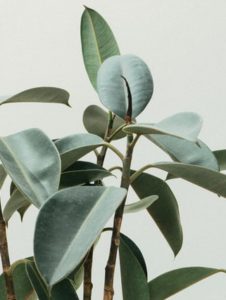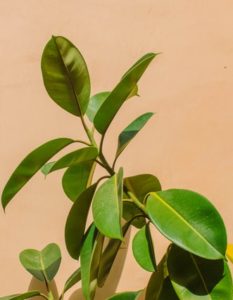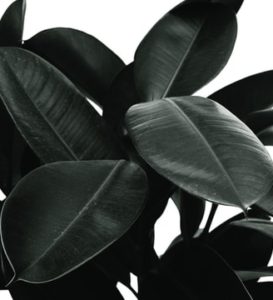Some of the links in the post are affiliate links and I receive a commission for purchases made through some of the links in the post.
Most people opt for indoor plants that require minimal maintenance.
However, the common mistake people make is that a sturdy plant that requires minimal maintenance can handle just about anything. But this is not the case.
The rubber treeknown scientifically as ficus elasticit’s one of those species that has found its way into people’s hearts and homes.
Even with minimal maintenance, this plant has proven to require more than the bare minimum. Leaf drop is a sign that even the toughest plants have their breaking points.
Today we are going to look at how to deal with fallen leaves and why they are there in the first place.
Contents
Why are the leaves of your rubber tree falling?
The first thing you need to know is that the rubber tree is not a self-sufficient plant.
In fact, the more it grows, the more it will appear droopy. But this applies to the stem, not the leaves. So, if the leaves start to fall, the following are likely to be the cause:
- You are overwatering your plant.
- You put your plant under water
- The humidity in the room is not optimal.
- You have exposed your plant to chemicals.
- Your plant is root bound.
- The plant does not receive enough light.
How do you keep your rubber plant leaves from hanging down?
Keeping rubber plant leaves from dropping requires a balance in all of its growing needs.
You need to ensure that it has adequate light and humidity, that it is properly watered, and that it is safe from pest attack.
We’ll look at each of these possible causes so you can locate and fix the problem in your home. Let’s start:
Poor root development.
 The rubber tree has spreading roots that grow with the height of the plant. When grown outdoors, the rubber tree can become somewhat invasive by spreading its roots over a wide area.
The rubber tree has spreading roots that grow with the height of the plant. When grown outdoors, the rubber tree can become somewhat invasive by spreading its roots over a wide area.
You can expect it to grow at a rapid pace, even indoors. Luckily, thanks to the pot, the roots won’t be as overbearing and will likely stop growing once the plant reaches 3 feet tall.
You need to transplant the plant as soon as it has roots. This transplant helps the plant to more easily absorb water and nutrients from the soil.
If this is not done, the plant will have poor growth, manifested by drooping leaves, leaf color change and stunted growth.
Depending on the variety, rubber plants should be transplanted every two to three years. When transplanting, you need to increase the size of the pot by one or two sizes, but no more.
Otherwise, the plant will focus on expanding the root system instead of growing up and out.
Since it is a houseplant, it is best to limit its growth by restricting the size of the pot, but not to the point where the plants cannot grow healthily.
For example, if the plant grows in a 1 gallon pot, you can choose a 2 or 3 gallon pot.
What about aerial roots?
You may have noticed that your plant has roots growing above the surface of the soil.
They are aerial roots that allow it to survive outdoors by anchoring itself to other elements as the plant grows and spreads.
Indoors it is not necessary and you can cut them or let them grow more.
You may also be interested: Why is my Pilea freezing?
Why do the leaves of your rubber tree fall after transplanting?
Sometimes this undergoes a shock transplant. However, to be safe, you must also water, overwater and over-fertilize the plant.
Rubber plants are hardy and need very little fertilizer, so you can always skip this step.
bad lighting
The common assumption is that all plants need direct access to light.
Although rubber plants do well in well-lit environments, they do not like direct sunlight and will burn.
Placing the plant in an area that receives little to no light will cause it to topple over.
You have to find a balance between too much exposure and too little exposure.
This is even more necessary if it is a variegated plant, as bright light is needed for the colors to pop.
Place the plant near a window and shield it from the sun with a window or other protective material.
Keep in mind that your plant may need more water in such conditions due to moisture loss through evaporation. We’ll get to that next.
Improper irrigation techniques.
There are two main mistakes you can make when watering a rubber plant. You can over or under water according to your needs.
When and how to water your plant?
 The water requirement of these plants depends on the growing season.
The water requirement of these plants depends on the growing season.
When the plant is actively growing, such as in summer, it needs more water than when it is dormant, such as in winter.
The soil should be moist but not wet to provide the plant with enough moisture to absorb the nutrients from the potting mix.
More water than this causes drowning and makes the roots prone to rot, which is deadly to the plant.
To find out if the plant needs water during the growing season, stick your finger a few inches into the soil.
If it seems damp, the plant may go without water for a day or two. If the soil seems dry, moisten it, but don’t soak it.
The leaves also need to stay moist throughout the growing season, and this can be achieved by misting them or rubbing them with a damp cloth.
When the plant goes dormant, the goal should be to keep it from dying by watering it only when necessary.
Stick your finger 2 inches into the soil and feel how dry it is. The soil should remain dry, but not too dry.
If the leaves start dropping, take this as an indication that the plant is not getting enough moisture.
You will need to moisten the soil, but not too much, as the plant does not need a lot of water during the phase.
Drooping leaves can also be an indication of root rot, requiring you to move the plants as noted above.
To check, turn the plant on its side and loosen the root ball.
If the root looks soggy and limp, transplant the plants after allowing the root ball to dry out in the sun for a few hours.
Variations in humidity and temperature
Rubber plants grow well in wet and humid areas due to their tropical origin. That’s not to say they don’t do well in less humid areas.
However, if you notice that your plant is not doing very well, temperature fluctuations could be the cause.
Temperatures can be at one end of the scale. Your home may be too cold or too warm to support ideal plant growth.
Ideally, the temperature should be between 60°F and 75°F.
During the colder months, the plant can withstand temperatures as low as 50°F. Consistency is very important with these plants and a slight variation can cause the plants to sag.
Start by assessing the temperature range in your home and see if you’ve recently experienced drastic temperature changes.
If temperatures seem below or above the specified range, move the plant to an area within the ideal range.
chemical exposure
Generally, your rubber tree will not require additional fertilizer and the potting soil will be sufficient to support growth.
But if you decide to add fertilizer, do it during the active growing season and apply it according to the manufacturer’s instructions.
If you use too much fertilizer, the leaves will curl.
These effects can also occur if the leaves have been exposed to other contaminants, such as gas vapors in the air.
The only way to deal with contamination is to repot the plant with fresh potting soil.
parasitic infection
Your plant can also be attacked by pests such as spider mites, aphids, scale insects and scale insects.
On the plus side, if you catch these attacks early, you can easily get rid of the pests by cleaning the leaves with warm soapy water.
Insecticidal soaps are also available. Keep in mind that overwatering your plant can also make it more susceptible to plant diseases.
Why are your leaves curling?
Besides exposure to chemicals, these effects can be due to poor irrigation techniques and low humidity.
Note that when new growth occurs, the leaves tend to curl up until they are fully developed. In this case, it is a normal phenomenon and there is no need to worry about it.
Final Thoughts: How do you keep your rubber plant leaves from drooping?
 Your rubber plant needs balance in all of its growing needs.
Your rubber plant needs balance in all of its growing needs.
If you focus on lighting and forget to check humidity, watering or pests, your plant will fall.
Unfortunately, some of these issues, like overwatering, are serious and can kill your plant.
The best way forward is to monitor every aspect of your plant and make changes as needed.
Before you go, here are some more related articles that I encourage you to read below to solve more of your gardening problems:
Is ground coffee good for fig trees?
Why does your fiddle leaf fig tree have multiple stems?
The 3 Best Pots for a Fiddle Leaf Fig Tree
Happy gardening!
Written by: Daisy Njeric